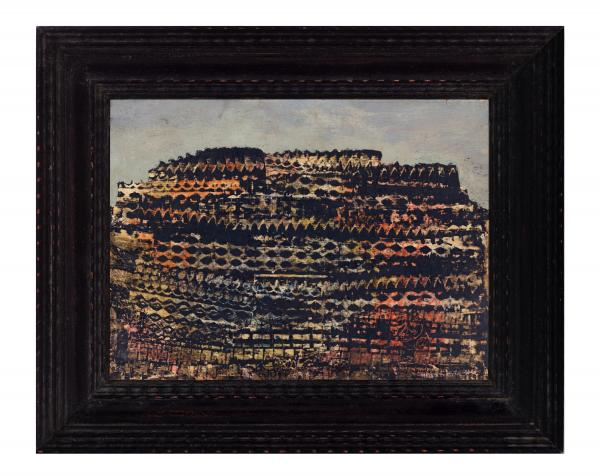Surrealism is one of the most generative movements of the 20th century. Though firmly anchored in Europe of the 1920s, it is increasingly being viewed as an international movement, and continues to influence artists. This is the first painting by Max Ernst, one of the founders of Surrealism, in LACMA’s collection.
In his native Germany, and then in France in the 1920s and 30s, Ernst created Surrealist works that are disquieting, illogical, and filled with imagery that is unexpected and uncanny, or as the surrealist poet Lautréamont described it: “As beautiful as the chance encounter of a sewing machine and an umbrella on an operating table.”
In his key Surrealist years, Ernst turned frequently to nature—creating several series of paintings of gloomy forests, jungles with demonic creatures, and citadels devoid of human population. His art continued to reflect the menacing atmosphere of war.
The Entire City is one of a series of paintings Ernst made in 1935–36. This intimate work uses grattage (a technique that Ernst contributed to Surrealism, of rubbing and scraping paper and paint to produce an image) to define the urban ruin. The bleak citadel is spare and mysterious. Is it a reminder of an abandoned city from an ancient civilization or an ominous harbinger of the National Socialist assault on Europe?
In 1941 Ernst, forced to flee his adopted country, France, for safety in the United States, joined fellow Surrealists in New York. He showed at Peggy Guggenheim’s gallery, achieved critical success, and his work, with its emphasis on automatism, the unconscious, and the metaphor, became an important conduit of European Surrealism for young American abstract expressionists.
The Entire City will become a critical link in LACMA’s growing collection of Surrealist painting and sculpture, and is the first painting by Ernst in a public Los Angeles collection.
During our 37th annual Collectors Committee Weekend (April 21–22, 2023), members of LACMA's Collectors Committee generously helped the museum acquire 10 works of art spanning a breadth of eras and cultures. Read more about all the acquisitions.



